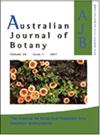The leaf micromorphology and anatomy of gamba grass, Andropogon gayanus Kunth (Poaceae: Panicoideae)
IF 0.9
4区 生物学
Q4 PLANT SCIENCES
引用次数: 0
Abstract
Context Andropogon gayanus, commonly known as gamba grass, is one of the declared weeds of national significance in Australia. Past studies have focused on gross morphology of root structures, biogeochemical behaviour, and ecology, but there has been limited work on comparative descriptions of leaf micromorphology and anatomy. Aims We investigated and described its leaf micromorphology and anatomy to understand weed biology and ecophysiology. Methods Optical and scanning electron microscope examination of the adaxial and abaxial leaf surfaces of A. gayanus was carried out. We identified and generated a list of morphological characters that were used to compare several dried herbarium specimens of A. gayanus. Key results The leaf characters were consistent across all specimens examined, with minor differences in leaf pubescence, indicating this could be a plastic trait. Conclusions Andropogon gayanus leaves are well adapted to wet and dry tropical conditions. Plasticity in leaf surface pubescence possibly enhances its adaptability, increasing its success as a weed in Australian ecosystems. The success of A. gayanus in Australia could be because the environment compares favourably with the native environment of the species in Africa, where it has adapted to extremes of wet and dry conditions over a large geographical range. Implications Plant morphological and taxonomic studies of A. gayanus focused on describing characters of spikelets and caryopses are recommended to understand how reproductive structures aid in its successful proliferation.冈巴草(Poaceae: Panicoideae)的叶片微观形态和解剖结构
背景 Andropogon gayanus,俗称甘巴草,是澳大利亚宣布的国家级重要杂草之一。过去的研究主要集中在根部结构的总体形态、生物地球化学行为和生态学方面,但对叶片微形态和解剖学的比较描述还很有限。目的 我们调查并描述了它的叶片微观形态和解剖结构,以了解杂草的生物学和生态生理学。方法 我们用光学显微镜和扫描电子显微镜对 Ayanus 的正面和背面进行了检查。我们鉴定并生成了一份形态特征列表,用于比较几份干燥的同性恋草标本。主要结果 所有受检标本的叶片特征一致,叶片短柔毛略有不同,表明这可能是一种可塑性特征。结论 Andropogon gayanus 的叶片能很好地适应潮湿和干燥的热带环境。叶片表面短柔毛的可塑性可能会增强其适应性,使其更容易成为澳大利亚生态系统中的杂草。A. gayanus在澳大利亚取得成功的原因可能是澳大利亚的环境与该物种在非洲的原生环境相比更为有利,在非洲,该物种在很大的地理范围内都能适应极端的干湿条件。影响 建议对 A. gayanus 进行植物形态学和分类学研究,重点描述小穗和子房的特征,以了解生殖结构如何帮助其成功繁殖。
本文章由计算机程序翻译,如有差异,请以英文原文为准。
求助全文
约1分钟内获得全文
求助全文
来源期刊

Australian Journal of Botany
生物-植物科学
CiteScore
2.30
自引率
18.20%
发文量
26
审稿时长
6-12 weeks
期刊介绍:
Australian Journal of Botany is an international journal for publication of original research in plant science. We seek papers of broad interest with relevance to Southern Hemisphere ecosystems. Our scope encompasses all approaches to understanding plant biology.
Australian Journal of Botany is published with the endorsement of the Commonwealth Scientific and Industrial Research Organisation (CSIRO) and the Australian Academy of Science.
 求助内容:
求助内容: 应助结果提醒方式:
应助结果提醒方式:


